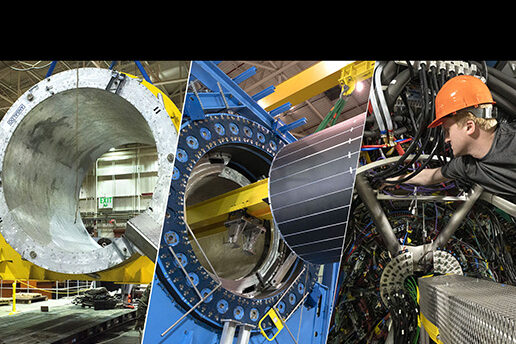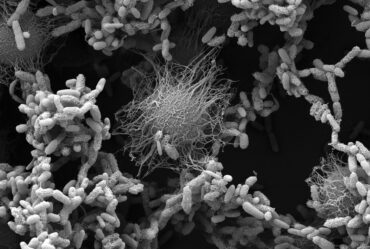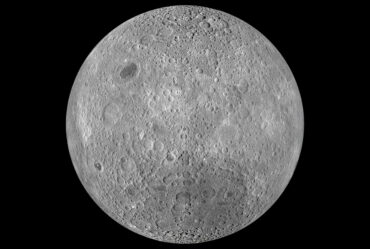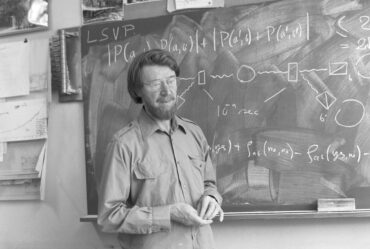
sPHENIX Detector is Ready for Collisions
More than a decade in the making, the advanced particle detector moves from assembly to active experiment
The state-of-the-art sPHENIX detector is fully assembled and gearing up to grab particle collision snapshots. The completion of assembly marks the detector’s transition from a construction project to running experiment at the Relativistic Heavy Ion Collider (RHIC), a U.S. Department of Energy Office of Science user facility for nuclear physics research at Brookhaven National Laboratory.
“It’s really a major milestone in the career of hundreds of people who have been working on sPHENIX, the concept, for more than a decade and on the concrete realization as a detector for seven or eight years,” said MIT physicist and sPHENIX co-spokesperson Gunther Roland. “Now we are just days away from putting the device that we have been working on into action.”
That will happen when RHIC Run 23 begins next week and the sPHENIX team starts commissioning their house-sized, 1000-ton detector.
“The focus of this run is to make sure sPHENIX performs the way we expect,” Roland said. “Then, if everything goes well, and that’s the plan, we will spend part of this year’s run actually doing physics—and at data-taking rates that have not been achieved at RHIC before.”
Construction capstone
Up until now, the sPHENIX project was an organized effort to both build the detector and upgrade the facility in which the detector will operate.
“A lot of the effort to build the detector itself has taken place away from Brookhaven, at collaborating institutions in the U.S. and around the world,” noted Brookhaven Lab physicist and sPHENIX co-spokesperson Dave Morrison. “There have been times when some of those folks have come to the Lab, and there were a lot of students helping to put things together. But those were sort of episodic. Now we are seeing all these people descend on sPHENIX and there is this big handoff from the project to the collaboration.”
Over the last two years the sPHENIX project team pulled off a carefully orchestrated logistical, engineering, and scientific feat. While RHIC continued to run, taking data with its STAR detector, the sPHENIX crew carried-out its detailed installation plan. Tasks ranged from landing the experiment’s cornerstone 20-ton cylindrical superconducting magnet to mapping its magnetic field, installing the time projection chamber, and precisely positioning multi-million channel advanced particle tracking components inside the detector volume.
The sPHENIX team tackled many challenges: coordinating shipments of key components across the globe; navigating supply-chain disruptions brought on by the COVID-19 pandemic and international conflict; recovering from a commercial warehouse fire that destroyed a key detector component; managing restrictions on travel for both vendors and Brookhaven Lab staff; overcoming multi-month shutdowns of companies and collaborating institutions; and devising new ways to collaborate in a remote-work environment.
The final detector components installed in early April presented one of the project’s most complicated assembly jobs.
sPHENIX’s delicate and compact micro vertex (MVTX) silicon detector is about a foot long and 3.5 inches in diameter. Its final home sits within a larger, super-fast silicon strip detector known as the INTT, which crews successfully installed in March. The trick was to slide the MVTX into place with only about a millimeter of clearance within the INTT and around the fragile beryllium beampipe through which RHIC beams circulate near the speed of light.
“Inserting the MVTX into the space between the INTT and the beampipe was really sort of a high-wire act that we had spent half a year practicing—that, therefore, in the end, went very smoothly,” Roland said.
Damage to the beampipe would have been a disaster, so everyone breathed a sigh of relief when the MVTX was in place.
“Now the beampipe couldn’t be in a more protected place,” Morrison said. “There’s a thousand tons of sPHENIX all around it protecting it.”
Facility upgrades
“Though building the sPHENIX detector was the coolest part of the project, over half of the work involved upgrading the old PHENIX facility to support sPHENIX,” said sPHENIX Project Director Ed O’Brien. sPHENIX occupies the building complex previously occupied by PHENIX, one of the original RHIC detectors. That building had last been upgraded in the mid-1990’s.
Like many modern installations, sPHENIX needs water, electricity, safety and protection systems, electronics cooling, computing, specialized gases, rigging and lifting systems, as well as features to access the detector.
“A remarkable group of dedicated technicians, engineers, designers, surveyors, electricians, carpenters, riggers, and safety personnel upgraded the sPHENIX facilities while the sPHENIX detector was getting installed in parallel,” O’Brien said. “The army performing this work came from the Lab’s Collider-Accelerator Department (C-AD), Physics Department, Advanced Technology Research Office, Facilities & Operations, National Synchrotron Light Source II, and collaborating outside institutions. Important contributions were also made by Procurement and Property Management, the Office of Planning, Performance, and Quality Management, Environment, Safety, &Health the Nuclear and Particle Physics Directorate, and Business Operations.”
“All played a vital role in the completion of sPHENIX. This is a perfect example of a truly lab-wide effort. They made this possible,” O’Brien said.
Brookhaven Lab physicist and sPHENIX project scientist John Haggerty, who refers to himself as one of the first sPHENIX employees at Brookhaven, said, “Working at a national lab, it is an incredible national resource; our group of engineers and technicians at sPHENIX are absolutely the best group you can work with. They’re just incredible.”
Morrison noted that, “The workforce from C-AD that has descended on sPHENIX has been amazing—building new stuff, installing things, doing all the things they have expertise in. And we at sPHENIX are totally dependent on and benefiting from their expertise enormously.”
“There’s a lot of excitement out there, even among people that aren’t members of the collaboration,” he added.
Looking back on the whole process—from proposing a detector to taking part in designing and building it and seeing it through to fruition—Roland summed up, “This is an opportunity that, in the lifetime of an experimental physicist, if one is lucky, only comes around a few times.”
Brookhaven National Laboratory is supported by the Office of Science of the U.S. Department of Energy. The Office of Science is the single largest supporter of basic research in the physical sciences in the United States and is working to address some of the most pressing challenges of our time. For more information, please visit science.energy.gov.
Follow @BrookhavenLab on Twitter or find us on Facebook.
- Original article: sPHENIX Detector is Ready for Collisions [Brookhaven National Laboratory, 5.1.2023]


